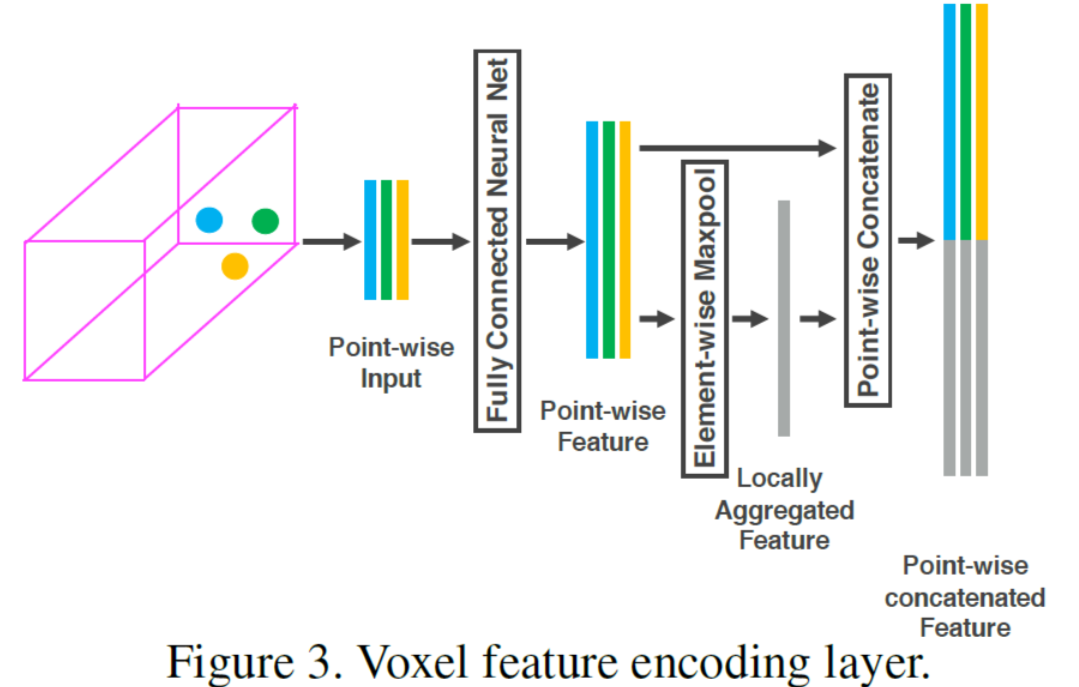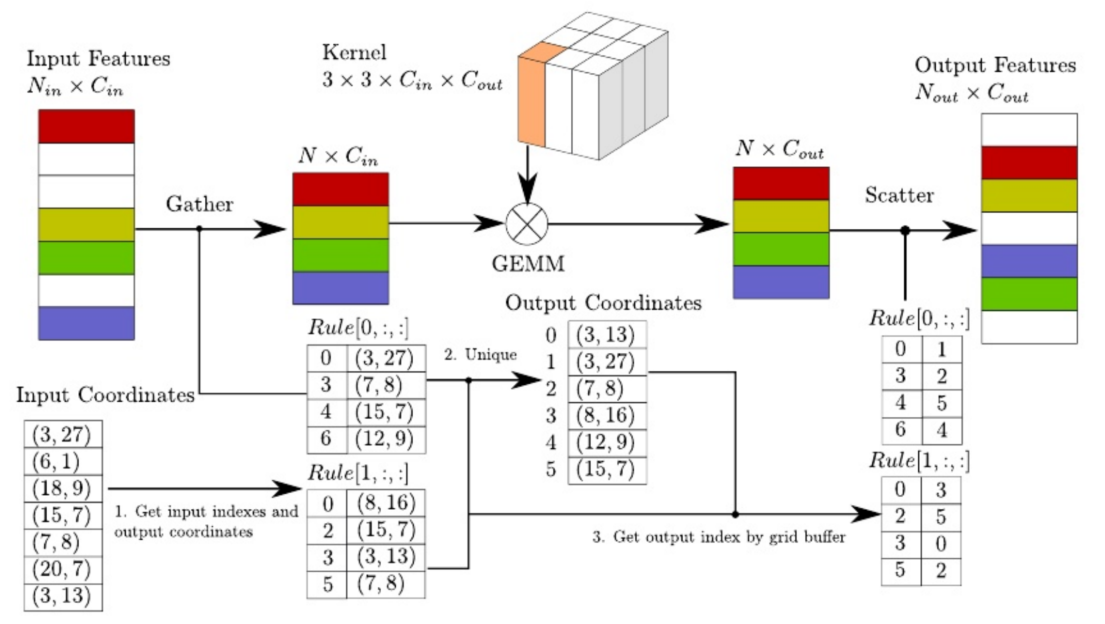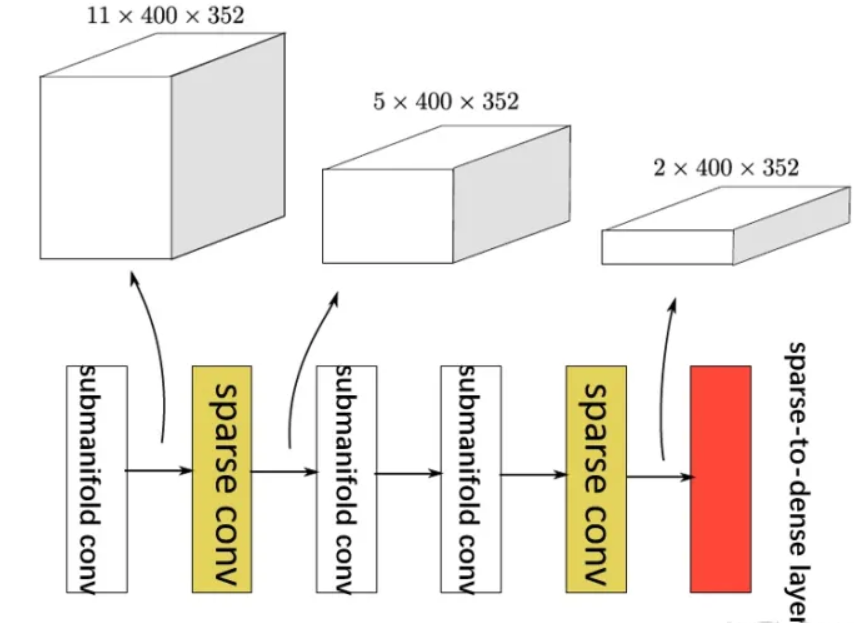1.VFE

import torch
from .vfe_template import VFETemplate
class MeanVFE(VFETemplate):
def __init__(self, model_cfg, num_point_features, **kwargs):
super().__init__(model_cfg=model_cfg)
self.num_point_features = num_point_features
def get_output_feature_dim(self):
return self.num_point_features
def forward(self, batch_dict, **kwargs):
"""
Args:
batch_dict:
voxels: (num_voxels, max_points_per_voxel, C)
voxels:表示num_voxels 体素的数量,max_points_per_voxel每个体素所容纳的最大点的数量,C是每个点的特征数量,表示每个点的属性或特征的维度
voxel_num_points: optional (num_voxels)
voxel_num_points表示voxel_num_points参数可选,并且长度和num_voxels匹配
**kwargs:
Returns:
vfe_features: (num_voxels, C)
"""
voxel_features, voxel_num_points = batch_dict['voxels'], batch_dict['voxel_num_points']#在batch_dict里面找到voxel_features和voxel_num_points
points_mean = voxel_features[:, :, :].sum(dim=1, keepdim=False)#对所有维度进行一个切片操作,并且在第一维度求和,求和后不保留维度,即返回形状为 (num_voxels, C) 的结果
normalizer = torch.clamp_min(voxel_num_points.view(-1, 1), min=1.0).type_as(voxel_features)#正则化项, 保证每个voxel中最少有一个点,防止除0
points_mean = points_mean / normalizer## 求每个voxel内点坐标的平均值
batch_dict['voxel_features'] = points_mean.contiguous()#将处理好的voxel_feature信息重新加入batch_dict中
return batch_dict
2.稀疏卷积

##稀疏卷积构建block
def post_act_block(in_channels, out_channels, kernel_size, indice_key=None, stride=1, padding=0,
conv_type='subm', norm_fn=None):
## 后处理执行块,根据conv_type选择对应的卷积操作并和norm与激活函数封装为块
if conv_type == 'subm':
conv = spconv.SubMConv3d(in_channels, out_channels, kernel_size, bias=False, indice_key=indice_key)
elif conv_type == 'spconv':
conv = spconv.SparseConv3d(in_channels, out_channels, kernel_size, stride=stride, padding=padding,
bias=False, indice_key=indice_key)
elif conv_type == 'inverseconv':
conv = spconv.SparseInverseConv3d(in_channels, out_channels, kernel_size, indice_key=indice_key, bias=False)
else:
raise NotImplementedError
m = spconv.SparseSequential(
conv,
norm_fn(out_channels),
nn.ReLU(),
)
return m
class VoxelBackBone8x(nn.Module):
def __init__(self, model_cfg, input_channels, grid_size, **kwargs):
super().__init__()
self.model_cfg = model_cfg
norm_fn = partial(nn.BatchNorm1d, eps=1e-3, momentum=0.01)#实现批归一化
self.sparse_shape = grid_size[::-1] + [1, 0, 0]
#稀疏数据中以 z、y、x 的顺序表示维度,所以grid_size[::-1将x,y,z变为z,y,x
#将偏移量 [1, 0, 0] 追加到反转后的 grid_size 列表之后,形成一个新的列表
self.conv_input = spconv.SparseSequential(
spconv.SubMConv3d(input_channels, 16, 3, padding=1, bias=False, indice_key='subm1'),#创建一个稀疏卷积层对象
norm_fn(16),#输入通道数为16的再进行一个批归一化
nn.ReLU(),#进行一个激活函数
)
block = post_act_block
self.conv1 = spconv.SparseSequential(
block(16, 16, 3, norm_fn=norm_fn, padding=1, indice_key='subm1'),
)
#self.conv1创建一个稀疏卷积层对象。
self.conv2 = spconv.SparseSequential(
# [1600, 1408, 41] <- [800, 704, 21]
block(16, 32, 3, norm_fn=norm_fn, stride=2, padding=1, indice_key='spconv2', conv_type='spconv'),
block(32, 32, 3, norm_fn=norm_fn, padding=1, indice_key='subm2'),
block(32, 32, 3, norm_fn=norm_fn, padding=1, indice_key='subm2'),
)#self.conv2包含了三个稀疏卷积层
self.conv3 = spconv.SparseSequential(
# [800, 704, 21] <- [400, 352, 11]
block(32, 64, 3, norm_fn=norm_fn, stride=2, padding=1, indice_key='spconv3', conv_type='spconv'),
block(64, 64, 3, norm_fn=norm_fn, padding=1, indice_key='subm3'),
block(64, 64, 3, norm_fn=norm_fn, padding=1, indice_key='subm3'),
)#self.conv3包含了三个稀疏卷积层
self.conv4 = spconv.SparseSequential(
# [400, 352, 11] <- [200, 176, 5]
block(64, 64, 3, norm_fn=norm_fn, stride=2, padding=(0, 1, 1), indice_key='spconv4', conv_type='spconv'),
block(64, 64, 3, norm_fn=norm_fn, padding=1, indice_key='subm4'),
block(64, 64, 3, norm_fn=norm_fn, padding=1, indice_key='subm4'),
)#self.conv4包含了三个稀疏卷积层
last_pad = 0
last_pad = self.model_cfg.get('last_pad', last_pad)#从模型配置中获取到的值,如果模型配置中不存在 'last_pad' 键,则 last_pad 保持不变。
self.conv_out = spconv.SparseSequential(
# [200, 150, 5] -> [200, 150, 2]
spconv.SparseConv3d(64, 128, (3, 1, 1), stride=(2, 1, 1), padding=last_pad,
bias=False, indice_key='spconv_down2'),
norm_fn(128),
nn.ReLU(),
)#创建一个稀疏卷积层对象,进行一个批归一化和Relu激活函数
self.num_point_features = 128
self.backbone_channels = {
'x_conv1': 16,
'x_conv2': 32,
'x_conv3': 64,
'x_conv4': 64
}
def forward(self, batch_dict):
"""
Args:
batch_dict:
batch_size: int
vfe_features: (num_voxels, C)
voxel_coords: (num_voxels, 4), [batch_idx, z_idx, y_idx, x_idx]
Returns:
batch_dict:
encoded_spconv_tensor: sparse tensor
"""
voxel_features, voxel_coords = batch_dict['voxel_features'], batch_dict['voxel_coords']
batch_size = batch_dict['batch_size']
input_sp_tensor = spconv.SparseConvTensor(
features=voxel_features,
indices=voxel_coords.int(),
spatial_shape=self.sparse_shape,
batch_size=batch_size
)
#创建的稀疏卷积的输入张量对象,该对象包含了特征值、索引、空间形状和批次大小等信息,可以作为稀疏卷积神经网络模型的输入。
x = self.conv_input(input_sp_tensor)
x_conv1 = self.conv1(x)
x_conv2 = self.conv2(x_conv1)# [1600, 1408, 41] -> [800, 704, 21]
x_conv3 = self.conv3(x_conv2)# [800, 704, 21] ->[400, 352, 11]
x_conv4 = self.conv4(x_conv3)# [400, 352, 11] -> [200, 176, 5]
# for detection head
out = self.conv_out(x_conv4) # [200, 176, 5] -> [200, 176, 2]
#将这些键值对添加到了 batch_dict 中
batch_dict.update({
'encoded_spconv_tensor': out,
'encoded_spconv_tensor_stride': 8
})
batch_dict.update({
'multi_scale_3d_features': {
'x_conv1': x_conv1,
'x_conv2': x_conv2,
'x_conv3': x_conv3,
'x_conv4': x_conv4,
}
})
batch_dict.update({
'multi_scale_3d_strides': {
'x_conv1': 1,
'x_conv2': 2,
'x_conv3': 4,
'x_conv4': 8,
}
})
return batch_dict
3.稀疏卷积中间提取器

import torch.nn as nn
#再高度方向上面进行一个压缩
class HeightCompression(nn.Module):
def __init__(self, model_cfg, **kwargs):
super().__init__()
self.model_cfg = model_cfg
self.num_bev_features = self.model_cfg.NUM_BEV_FEATURES#高度的特征数
def forward(self, batch_dict):
"""
Args:
batch_dict:
encoded_spconv_tensor: sparse tensor
Returns:
batch_dict:
spatial_features:
"""
encoded_spconv_tensor = batch_dict['encoded_spconv_tensor']#得到VoxelBackBone8x的输出特征里面的batch_dict
spatial_features = encoded_spconv_tensor.dense()#将稀疏的tensor转化为
#密集tensor,[bacth_size, 128, 2, 200, 176]目的为了结合batch,spatial_shape、indice和feature将特征还原到密集tensor中对应位置
N, C, D, H, W = spatial_features.shape## batch_size,128,2,200,176
spatial_features = spatial_features.view(N, C * D, H, W)
"""
将密集的3D tensor reshape为2D鸟瞰图特征
将两个深度方向内的voxel特征拼接成一个 shape : (batch_size, 256, 200, 176)
z轴方向上没有物体会堆叠在一起,这样做可以增大Z轴的感受野,
同时加快网络的速度,减小后期检测头的设计难度
"""
batch_dict['spatial_features'] = spatial_features#将特征和采样尺度加入batch_dict
batch_dict['spatial_features_stride'] = batch_dict['encoded_spconv_tensor_stride']# 特征图的下采样倍数为8倍
return batch_dict
4.RPN
def forward(self, data_dict):
"""
Args:
data_dict:
spatial_features
Returns:
"""
spatial_features = data_dict['spatial_features']
ups = []
ret_dict = {}
x = spatial_features
# 对不同的分支部分分别进行conv和deconv的操作
for i in range(len(self.blocks)):
"""
SECOND中存在两个下采样,则分别对两个下采样分支进行反卷积操作
分支一: (batch,128,200,176)-->(batch,256,200,176)
分支二: (batch,256,100,88)-->(batch,256,200,176)
"""
x = self.blocks[i](x)#则表示将输入张量 x 作为参数传递给第 i 个块,并将计算结果赋值给 x。
stride = int(spatial_features.shape[2] / x.shape[2])#通过将 spatial_features 的深度(depth)维度大小除以x的深度维度大小得到。这个步长值可能用于进一步的操作。
ret_dict['spatial_features_%dx' % stride] = x#将步长值和 x 的值作为键值对添加到 ret_dict 字典中。
if len(self.deblocks) > 0:
ups.append(self.deblocks[i](x))
else:
ups.append(x)
if len(ups) > 1:
"""
最终经过所有上采样层得到的2个尺度的的信息
每个尺度的 shape 都是 (batch,256,200,176)
在第一个维度上进行拼接得到x 维度是 (batch,512,200,176)
"""
x = torch.cat(ups, dim=1)
elif len(ups) == 1:
x = ups[0]
if len(self.deblocks) > len(self.blocks):
x = self.deblocks[-1](x)
data_dict['spatial_features_2d'] = x
return data_dict

























 1万+
1万+

 被折叠的 条评论
为什么被折叠?
被折叠的 条评论
为什么被折叠?








